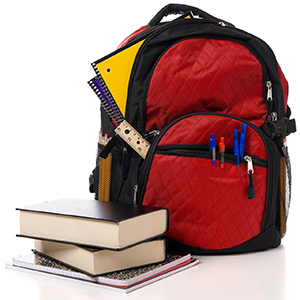BACKPACK SMARTS

By Karen Jacobs
I’ve seen it happen many times over the years. It’s the first day of school, and I am walking my two children to school and we will pass a group of middle school-aged students who are slowly making their way to their school and one will lose his balance carrying a backpack that looks like a small dorm refrigerator or a small car trunk. When he lands on his back, I envision an image of a turtle on its back with its legs in the air as he attempts to right himself. I then turn to my children and ask, how heavy are your backpacks?
More than one million New York City students in kindergarten through twelfth grade will pack and wear backpacks when school begins again this year. However, these children may also come home from school not only saying that the first day of school was fun, but sharing that they have an aching back, sore shoulders, tingling in their arms, or even a headache. Although we can’t attribute all of this discomfort exclusively to their backpacks, parents can take steps to help their children with backpack use.
THE PROPER FIT
The road to a correctly fit backpack begins with back-to-school shopping. By joining as a team and making backpack shopping a family affair, children start to learn the importance of proper selection, packing and wearing a backpack. Backpack shopping and considering the quality of the item is an excellent way to have children begin to take more responsibility for their physical health.
As an occupational therapist, I’m concerned about the growing problem posed by improper backpack use. We risk long-term damage to our children’s growing bodies by remaining silent on this public health issue. Given this concern, the American Occupational Therapy Association (AOTA) started National School Backpack Awareness Day™. In its 17th year, it is the longest running public health initiative in the profession of occupational therapy. Every third Wednesday in September, occupational therapy practitioners, educators, parents, and students conduct “weigh-ins” at schools, malls, libraries among other locations to help educate children, parents, school administrators, teachers, and the community about the “how to” for backpacks - to “pack it right and wear it light.”
There is the real effectiveness of backpack education. In a study, almost eight out of 10 middle school children who had been educated on backpack safety subsequently changed how they loaded their backpacks and ultimately, reported less discomfort in their backs, necks, and shoulders. There are three simple steps to follow when selecting and purchasing a backpack.

School backpacks come in different sizes for different ages. Choose the right size pack for your child as well as one with enough room for necessary school items.
• The height of the backpack should extend from approximately two inches below the shoulder blades to waist level or slightly above the waist
• Select a pack with well-padded shoulder straps. Shoulders and necks have many blood vessels and nerves that can cause pain and tingle in the neck, arms, and hands when too much pressure is applied.
• Choose a backpack with chest and hip straps which will help distribute the pack’s weight more evenly. The backpack should be made of lightweight material.
• As safety precautions, have a reflector on the back of the backpack and avoid having your child’s name or initials on the pack.
Your child’s backpack should weigh no more than about 10 percent of his or her body weight. This means a student weighing 100 pounds shouldn’t wear a loaded school backpack heavier than about 10 pounds.
• Pack heaviest items closest to your child’s back (the back of the pack).
• Arrange books and materials so that they won’t slide around in the backpack.
• Check what your child carries to school and brings home. Make sure the items are necessary for the day’s activities. I recommend packing a backpack before your child goes to sleep, so it is ready for the morning.
Distribute weight evenly by using both straps. Wearing a pack slung over one shoulder can cause a child to lean to one side, curving the spine and causing pain or discomfort.
• Adjust the shoulder straps so that the pack fits snugly on the child’s back. A pack that hangs loosely from the back can pull the child backward and strain muscles.
• Wear the chest and hip belt.
• The bottom of the pack should rest in the curve of the lower back. It should never rest more than four inches below the child’s waistline.
• If the backpack is too heavy or tightly packed, your child can hand carry a book or other item outside the pack.
• If the backpack is too heavy on a regular basis, consider using a book bag on wheels if your child’s school allows it.
I hope you will reach out to your school to learn if there is an AOTA National School Backpack Awareness Day™ event. If not, consider requesting one. We hope you will join occupational therapy practitioners, educators, and students across the country as we help others “Live Life to Its Fullest” by avoiding the discomfort that can come from backpack use.
For more information on the American Occupational Therapy Association (AOTA), visit aota.org.

Karen Jacobs, OT, OTR, Ed.D., CPE, FAOTA, is a Clinical Professor at Boston University (BU), College of Health and Rehabilitation Sciences: Sargent College. She is the national spokesperson for the AOTA National School Backpack Awareness Day™ and can be contacted at kjacobs@bu.edu.




